Subendocardial or non q - Study guides, Class notes & Summaries
Looking for the best study guides, study notes and summaries about Subendocardial or non q? On this page you'll find 44 study documents about Subendocardial or non q.
Page 2 out of 44 results
Sort by

-
PCCN EXAM Questions With 100% Verified Answers Latest Update 2024/2025 (GRADED)
- Exam (elaborations) • 50 pages • 2024
-
- $17.49
- + learn more
PCCN EXAM Questions With 100% Verified Answers Latest Update 2024/2025 (GRADED) Coronary artery perfusion is dependent upon: A. diastolic pressure B. systolic pressure C. afterload D. systemic vascular resistance (SVR) A. diastolic pressure Diastolic pressure in the aortic root is higher than left ventricular end-diastolic pressure (LVEDP), the pressure exerted on the ventricular muscle at the end of diastole when the ventricle is full. This enables blood to flow from a higher pressure ...
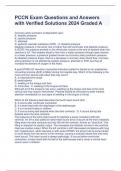
-
PCCN Exam Questions and Answers with Verified Solutions 2024 Graded A
- Exam (elaborations) • 56 pages • 2024
-
- $14.49
- + learn more
Coronary artery perfusion is dependent upon: A. diastolic pressure B. systolic pressure C. afterload D. systemic vascular resistance (SVR) - A. diastolic pressure Diastolic pressure in the aortic root is higher than left ventricular end-diastolic pressure (LVEDP), the pressure exerted on the ventricular muscle at the end of diastole when the ventricle is full. This enables blood to flow from a higher pressure through open arteries to a lower pressure, a pressure gradient known as coronary a...
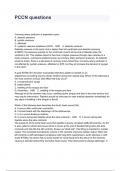
-
PCCN Exam Questions And Answers
- Exam (elaborations) • 56 pages • 2024
-
- $14.99
- + learn more
PCCN Exam Questions And Answers Coronary artery perfusion is dependent upon: A. diastolic pressure B. systolic pressure C. afterload D. systemic vascular resistance (SVR) - ANS A. diastolic pressure Diastolic pressure in the aortic root is higher than left ventricular end-diastolic pressure (LVEDP), the pressure exerted on the ventricular muscle at the end of diastole when the ventricle is full. This enables blood to flow from a higher pressure through open arteries to a lower pressur...
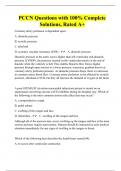
-
PCCN Questions with 100% Complete Solutions, Rated A+
- Exam (elaborations) • 90 pages • 2024
-
Available in package deal
-
- $13.99
- + learn more
Coronary artery perfusion is dependent upon: A. diastolic pressure B. systolic pressure C. afterload D. systemic vascular resistance (SVR) - A. diastolic pressure Diastolic pressure in the aortic root is higher than left ventricular end-diastolic pressure (LVEDP), the pressure exerted on the ventricular muscle at the end of diastole when the ventricle is full. This enables blood to flow from a higher pressure through open arteries to a lower pressure, a pressure gradient known as coronar...
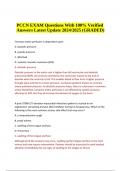
-
PCCN EXAM Questions With 100% Verified Answers Latest Update 2024/2025 (GRADED)
- Exam (elaborations) • 50 pages • 2024
-
- $16.49
- + learn more
PCCN EXAM Questions With 100% Verified Answers Latest Update 2024/2025 (GRADED) Coronary artery perfusion is dependent upon: A. diastolic pressure B. systolic pressure C. afterload D. systemic vascular resistance (SVR) A. diastolic pressure Diastolic pressure in the aortic root is higher than left ventricular end-diastolic pressure (LVEDP), the pressure exerted on the ventricular muscle at the end of diastole when the ventricle is full. This enables blood to flow from a higher pressure ...
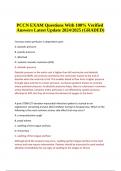
-
PCCN EXAM Questions With 100% Verified Answers, Latest Update 2024/2025 (GRADED)
- Exam (elaborations) • 50 pages • 2024
-
- $15.49
- + learn more
Coronary artery perfusion is dependent upon: A. diastolic pressure B. systolic pressure C. afterload D. systemic vascular resistance (SVR) A. diastolic pressure Diastolic pressure in the aortic root is higher than left ventricular end-diastolic pressure (LVEDP), the pressure exerted on the ventricular muscle at the end of diastole when the ventricle is full. This enables blood to flow from a higher pressure through open arteries to a lower pressure, a pressure gradient known as coronary...
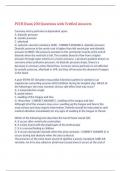
-
PCCN Exam 200 Questions with Verified Answers,100% CORRECT
- Exam (elaborations) • 73 pages • 2024
-
Available in package deal
-
- $12.99
- + learn more
PCCN Exam 200 Questions with Verified Answers Coronary artery perfusion is dependent upon: A. diastolic pressure B. systolic pressure C. afterload D. systemic vascular resistance (SVR) - CORRECT ANSWER A. diastolic pressure Diastolic pressure in the aortic root is higher than left ventricular end-diastolic pressure (LVEDP), the pressure exerted on the ventricular muscle at the end of diastole when the ventricle is full. This enables blood to flow from a higher pressure through open arter...
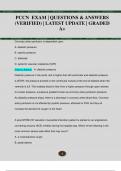
-
PCCN EXAM | QUESTIONS & ANSWERS (VERIFIED) | LATEST UPDATE | GRADED A+
- Exam (elaborations) • 118 pages • 2024
- Available in package deal
-
- $21.49
- + learn more
1 PCCN EXAM | QUESTIONS & ANSWERS (VERIFIED) | LATEST UPDATE | GRADED A+ Coronary artery perfusion is dependent upon: A. diastolic pressure B. systolic pressure C. afterload D. systemic vascular resistance (SVR) Correct Answer: A. diastolic pressure Diastolic pressure in the aortic root is higher than left ventricular end-diastolic pressure (LVEDP), the pressure exerted on the ventricular muscle at the end of diastole when the ventricle is full. This enables blood to flow from a ...
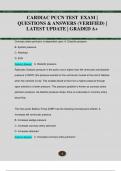
-
CARDIAC PCCN TEST EXAM | QUESTIONS & ANSWERS (VERIFIED) | LATEST UPDATE | GRADED A+
- Exam (elaborations) • 6 pages • 2024
- Available in package deal
-
- $10.49
- + learn more
1 CARDIAC PCCN TEST EXAM | QUESTIONS & ANSWERS (VERIFIED) | LATEST UPDATE | GRADED A+ Coronary artery perfusion is dependent upon: A. Diastolic pressure B. Systolic pressure C. Afterload D. SVR Correct Answer: A. Diastolic pressure Rationale: Diastolic pressure in the aortic root is higher than left ventricular end diastolic pressure (LVEDP) (the pressure exerted on the ventricular muscle at the end of diastole when the ventricle is full). This enables blood to flow from a hig...
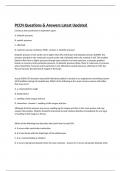
-
PCCN Questions & Answers Latest Updated
- Exam (elaborations) • 72 pages • 2023
- Available in package deal
-
- $12.99
- + learn more
Coronary artery perfusion is dependent upon: A. diastolic pressure B. systolic pressure C. afterload D. systemic vascular resistance (SVR) - Answer A. diastolic pressure Diastolic pressure in the aortic root is higher than left ventricular end-diastolic pressure (LVEDP), the pressure exerted on the ventricular muscle at the end of diastole when the ventricle is full. This enables blood to flow from a higher pressure through open arteries to a lower pressure, a pressure gradient known as cor...

How did he do that? By selling his study resources on Stuvia. Try it yourself! Discover all about earning on Stuvia


